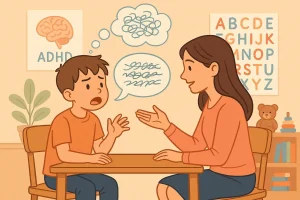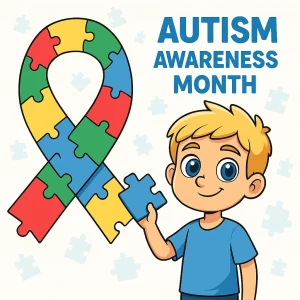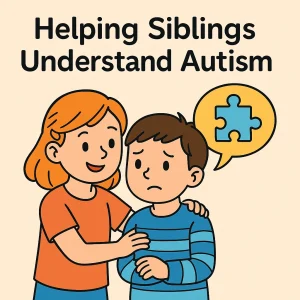Virtual Autism vs. Autism: What Parents Need to Know
By Rajini D
Last Updated: April 27, 2024
In our digital age, distinguishing between Autism Spectrum Disorder (ASD) and the emerging concept of Virtual Autism is crucial for supporting our children’s development effectively. While ASD is a well-established neurological condition, Virtual Autism arises from excessive screen time, presenting unique challenges. This article explores the critical differences and provides guidance to help parents and caregivers navigate these complexities with confidence. Let’s delve into understanding these conditions better, ensuring our approach to child development embraces both the real and virtual worlds effectively.
Define Autism
Autism Spectrum Disorder (ASD) is a complex neurological and developmental condition that affects how individuals perceive the world and interact with others. This disorder is called a “spectrum” because it manifests uniquely across different individuals, with symptoms ranging from mild to severe. ASD is characterized by challenges in social communication, social interaction, and the presence of repetitive behaviors and restricted interests.
Also Read: What is Autism Spectrum Disorder (ASD)
Neurological and Developmental Aspects: ASD’s neurological basis lies in the brain’s different processing of information. The condition affects the configuration and function of the brain, but the exact causes are still being explored through ongoing research. Developmentally, symptoms typically appear during early childhood and affect functions such as talking, playing, and interacting with others.
Common Signs and Symptoms:
- Social Communication Challenges: Difficulty in back-and-forth conversations, unusual tone of voice, and a literal interpretation of language.
- Social Interaction Difficulties: Trouble making eye contact, difficulty understanding other people’s feelings, and a preference for solitude.
- Repetitive Behaviors: Engaging in repetitive movements, such as rocking or spinning, and strict adherence to specific routines or behaviors.
- Diverse Presentations: While some individuals may require significant support in daily activities, others might lead independent lives but face challenges in social communication and interaction.
Know more about our article on 5 Early Signs of Autism Every Parent Should Know
Exploring Virtual Autism
Virtual Autism is a term that has emerged in recent discussions among parents, educators, and healthcare professionals. It describes a set of behaviors that resemble Autism Spectrum Disorder (ASD) symptoms, which some experts hypothesize may be triggered by excessive screen time during crucial stages of a child’s development.
Technology and Child Development: The hypothesis surrounding Virtual Autism suggests that prolonged exposure to digital screens can interfere with a child’s social and communicative development. Screens may replace the interactive human engagement necessary for learning social cues and language skills, potentially leading to autism-like behaviors. This includes delayed speech, poor eye contact, and limited social interaction.
Clarification on its Medical Recognition: It’s important to note that Virtual Autism is not recognized as a formal medical diagnosis within the healthcare community. Rather, it is a focus of ongoing research and debate. The term is used to describe observations of certain behavioral traits that increase with screen time but do not have a confirmed direct causation like traditional ASD.
Current Research and Discussions: Researchers are investigating how digital environments affect children differently and what long-term impacts may arise from early and intensive technology use. While the evidence is still evolving, the discussion prompts a crucial examination of our digital habits, especially in children’s daily routines.
Also Read: How to Put Off the Child from Gadgets? | How to Unplug My Kid?
Key Differences Highlighted
Navigating the nuanced landscape between autism and virtual autism requires an understanding of their key differences. While both conditions might share some behavioral traits, they are distinct in their onset, environmental factors, and how behaviors manifest. Here’s a straightforward comparison:
| Aspect | Autism | Virtual Autism |
|---|---|---|
| Causes | – Genetic Factors: Strong genetic basis with involvement of multiple genes. – Environmental Influences: Potential environmental factors during prenatal development. | – Technology Exposure: Primarily associated with excessive digital screen use. – Environmental Conditions: Lack of interactive play and direct human communication. |
| Onset | – Early Childhood: Symptoms typically appear by age 2 or 3. – Developmental Delays: Often noticed when developmental milestones are missed. | – Any Age: Can appear at any age, depending on screen exposure. – Behavioral Changes: Symptoms develop with prolonged screen use. |
| Symptoms | – Social Interaction: Difficulties with social cues and interactions. – Communication Challenges: Delays in language or conversational challenges. – Repetitive Behaviors: Engages in repetitive behaviors and has specific routines. | – Reduced Social Skills: Struggles with face-to-face interactions. – Attention Issues: Similar to attention deficit disorders. – Reversible Symptoms: Behaviors may improve with reduced screen time. |
| Reversibility | – Lifelong Condition: Symptoms can be managed, but ASD is a lifelong condition. | – Potentially Reversible: Symptoms may be reduced or eliminated by decreasing screen time and increasing direct human interaction. |
The Impact of Screen Time on Child Development
In an era where digital devices are ubiquitous, understanding the impact of screen time on child development is more crucial than ever. As parents and caregivers, it’s important to recognize how digital environments can influence developmental milestones and what this means for our children’s growth.

Influence on Developmental Milestones: Digital devices can offer educational content and stimulate cognitive development, but excessive screen time may lead to notable delays in crucial developmental areas. For young children, milestones related to physical activities, such as crawling or walking, can be delayed if they spend too much time in stationary activities like watching TV or playing tablet games. Similarly, excessive screen time can impact language skills and social interactions, as screens often do not provide the back-and-forth communication necessary for developing these critical skills.
Research Findings on Screen Time: Recent studies highlight several key concerns regarding screen time and child development:
- Language Delays: Research indicates that children who are exposed to more screen time may experience delays in language development. This is particularly evident in toddlers who spend significant time with handheld devices.
- Social Skills: Screens can replace the rich interactions with parents and peers that are essential for developing social skills. Children with excessive screen time may have difficulty understanding social cues and engaging in peer activities.
- Attention Span: The instant feedback and rapid shifts in content available on screens may lead to shorter attention spans in children. This can affect their ability to concentrate on tasks that require sustained attention and effort.
- Emotional Development: There is also a concern that overuse of screens may affect a child’s ability to regulate emotions. Without real-life interactions, children might struggle to manage frustrations or understand complex emotional contexts.
Guidelines for Healthy Screen Use: To mitigate these risks, it’s essential to follow recommended guidelines for screen use:
- Under 2 Years Old: Avoid screen time other than video chatting with family.
- Ages 2 to 5: Limit screen use to one hour per day of high-quality programming, co-viewed with an adult to help children understand what they are seeing.
Prevention and Management of Virtual Autism
Navigating the digital age as a parent involves balancing the benefits of technology with the potential for overuse, which can lead to symptoms of Virtual Autism. Here, we explore effective strategies for managing screen time and fostering physical and social development without the need for digital devices.
Effective Screen Time Management:
- Set Clear Limits: Establishing firm rules for when and how long children can use screens is crucial. For toddlers and preschoolers, limit screen use to one hour per day of high-quality, educational content. For older children, ensure that screen time doesn’t interfere with essential activities like homework, physical activity, and sleep.
- Create a Routine: Include screen time in your daily schedule at predictable times, and use it as an opportunity to engage with your child about what they are watching. This can transform passive screen time into an interactive learning experience.
- Be a Role Model: Children often emulate adult behaviors. By managing your own screen time, you set a behavioral standard, showing your child that there’s a time for screens and a time for other activities.

Promoting Physical and Social Development:
- Encourage Physical Play: Activities like running, jumping, and playing sports not only improve physical health but also enhance cognitive functions and social skills. Organize regular family outings to parks or playgrounds to encourage active play.
- Foster Social Interactions: Arrange playdates with peers or enroll your child in group activities like art classes or sports teams. These interactions are crucial for developing social skills, empathy, and emotional intelligence.
- Creative and Educational Activities: Engage your child in hands-on activities like puzzles, board games, and arts and crafts. These activities stimulate creativity and cognitive development without the need for digital screens.
- Read Together: Reading to your child and involving them in storytelling promotes language development and strengthens your bond. Choose books that are age-appropriate and discuss the stories to enhance comprehension and critical thinking skills.
Conclusion
Understanding the differences between Autism and Virtual Autism is key to supporting our children’s development. Autism is a lifelong condition with genetic roots, while Virtual Autism can emerge from too much screen time and might be reversible with the right steps. It’s crucial to manage technology use wisely and encourage active, social play. At Wellness Hub, we provide resources and tips to help families navigate these challenges effectively. Embrace a balanced approach to technology—your child’s well-being depends on it.
Frequently Asked Questions:
1. What is Autism Spectrum Disorder (ASD)?
Autism Spectrum Disorder (ASD) is a neurological and developmental disorder that affects communication and behavior. It’s called a “spectrum” because people with ASD can have a range of symptoms, from mild to severe, including challenges in social interaction, repetitive behaviors, and speech and nonverbal communication difficulties.
2. How is Virtual Autism different from traditional Autism?
Virtual Autism refers to behaviors similar to those of autism, observed primarily after excessive screen time. Unlike traditional autism, which is present from early childhood and involves a range of genetic and environmental factors, virtual autism is linked to environmental factors like prolonged digital exposure.
3. Can excessive screen time cause Autism?
Excessive screen time does not cause traditional autism. However, prolonged exposure to digital devices can lead to a condition informally known as “virtual autism,” where individuals exhibit behaviors similar to ASD. It’s important to balance screen time with interactive and outdoor activities.
4. What are the signs of Virtual Autism in children?
Signs of virtual autism can include reduced interest in physical play, difficulties in social interaction when not on digital devices, and delayed language skills. For example, with any concern regarding a child’s development, consulting a healthcare professional is advised if any of these signs are observed.
5. How can parents manage screen time for children?
Parents can manage screen time by setting clear guidelines and limits, engaging in screen-free activities as a family, and using screen time for interactive and educational purposes rather than passive consumption. Creating tech-free zones and times can also help establish healthy digital habits.
6. Where can I find support and resources for Autism and Virtual Autism?
Wellness Hub offers a comprehensive collection of resources, support options, and a community forum for families dealing with autism and virtual autism. From expert articles to practical advice and professional guidance, Wellness Hub aims to empower families with knowledge and support.
7. Is it possible to improve symptoms of Virtual Autism?
Improving symptoms of virtual autism involves reducing excessive screen time and increasing engagement in real-world activities that promote social interaction, physical play, and language development. Professional guidance can also offer tailored strategies for managing screen-related behaviors.
8. What role do genetics play in Autism Spectrum Disorder?
Genetics plays a significant role in Autism Spectrum Disorder (ASD). Research suggests that a combination of genes may contribute to the development of autism. While no single gene causes autism, variations in certain genes can increase a child’s risk. Environmental factors may also interact with genetic predispositions to influence the likelihood of ASD.
9. How can schools support children with autism or symptoms of virtual autism?
Schools can support children with autism or symptoms of virtual autism by providing tailored educational plans, incorporating sensory-friendly learning environments, and offering social skills training. It’s also important for schools to foster open communication with parents and involve specialists, such as speech therapists and occupational therapists, to address each child’s unique needs effectively.
10. Are there specific therapies recommended for managing autism?
Several therapies are recommended for managing autism, depending on individual needs. Applied Behavior Analysis (ABA) is widely recognized for improving social, communication, and learning skills through positive reinforcement. Occupational therapy can help with daily living skills, and speech therapy may improve communication abilities. Always consult a healthcare professional to determine the most suitable therapies for an individual’s situation.
About the Author:
Rajini Darugupally
M.Sc., Speech-Language Pathologist (9+ years of experience)
Rajini is a passionate and dedicated Speech-Language Pathologist with over 9+ years of experience, specializing in both developmental speech and language disorders in children and rehabilitation in adults. Driven by a desire to empower each individual to find their voice, Rajini brings a wealth of experience and a warm, genuine approach to therapy.
Currently, at Wellness Hub, she thrives in a team environment that values innovation, compassion, and achieving results for their clients.
Connect with Rajini to learn more about how she can help you or your loved one find their voice.
Book your Free Consultation Today
Parent/Caregiver Info:
Client’s Details:
* Error Message









